Davim J.P. Tribology for Engineers: A Practical Guide
Подождите немного. Документ загружается.

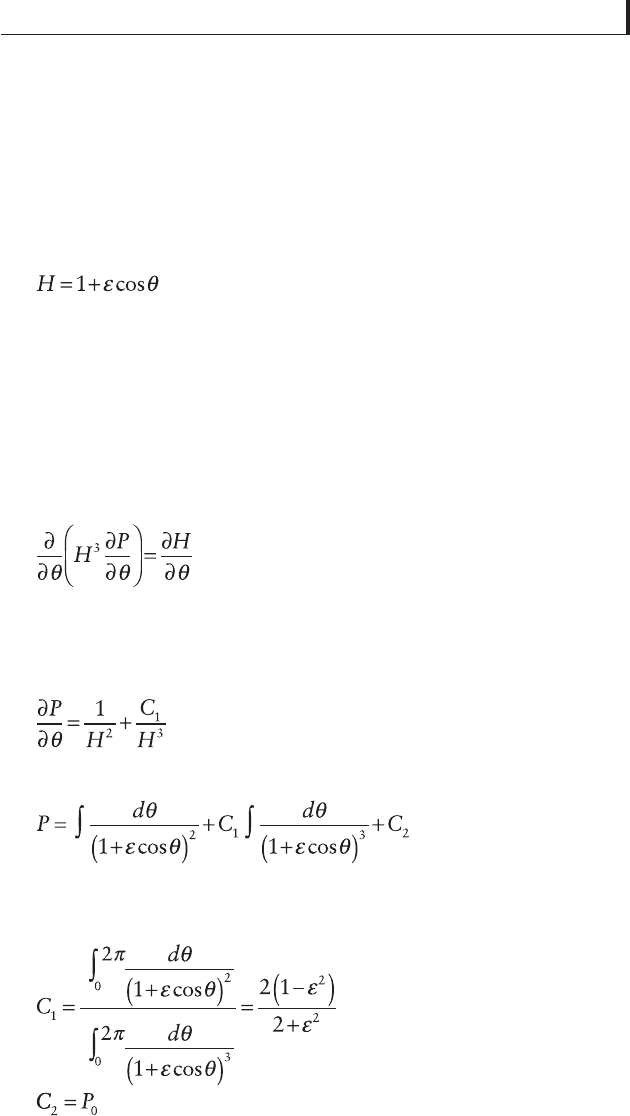
79
Lubrication and roughness
where
b
= R/L is the bearing scale factor, L is the bearing
length, and the velocity can be defi ned as u = R
ω
.
The gap between journal and bearing can also be presented
in dimensionless form, using the notations e for eccentricity of
journal center, c for clearance (c = R
b
– R), H = h/c, ε = e/c, and
representing the cylindrical surfaces by planes, as follows:
[3.20]
This expression is justifi ed usually at c/R
b
ratios smaller
than 0.1.
Assuming that the bearing parameters in the
θ
-direction
(x,y-plane) are less than the bearing length; a
b
< 1 (long
bearing, thus the pressure does not change along Z and
∂P/∂Z = 0); and when the gap confi guration does not change
with time, ∂H/∂T = 0, eq. [3.19] simplifi es to
[3.21]
The boundary conditions for this case are P(
θ
) = P(2
π
) = P
0
and called Sommerfeld’s conditions. After the fi rst integration
we have
[3.22]
and further integration of both parts of eq. [3.22] yields
[3.23]
The integration constants are determined subject to the
above boundary conditions, namely
[3.24]
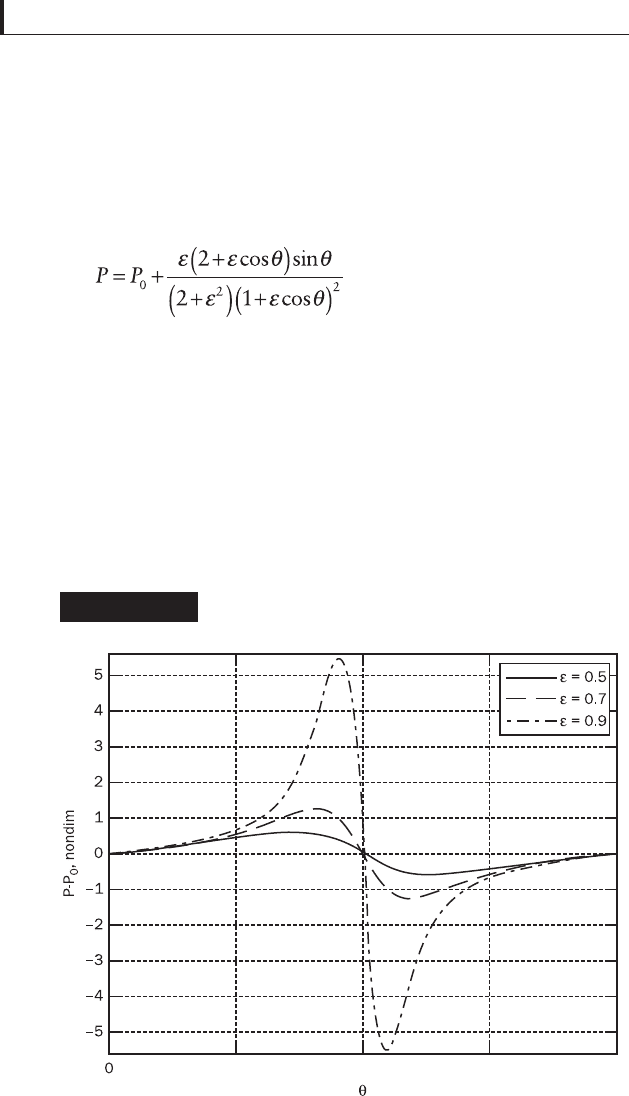
80
Tribology for Engineers
The integrals in eqs. [3.23] and [3.24], known as the journal-
bearing integrals, are obtainable for instance from Booker,
1965. Denoting the hydrodynamic pressure at
θ
= 0 by
P
0
(pressure at the initial angle), we have the pressure
distribution equation as
[3.25]
This solution was fi rst arrived at by Sommerfeld in 1904,
and remains topical to this day.
The redundant hydrodynamic pressures, P-P
0
, calculated
by eq. [3.25], are presented in Fig. 3.6 for several values of
the dimensionless eccentricity ε. The pressure in the solution
has positive and negative branches with equal maximum and
minimum. As can be seen, the pressure increases with the
p/2 p 3/2p 2p
Dimensionless pressure distribution as function
of angle at different eccentricities
Figure 3.6
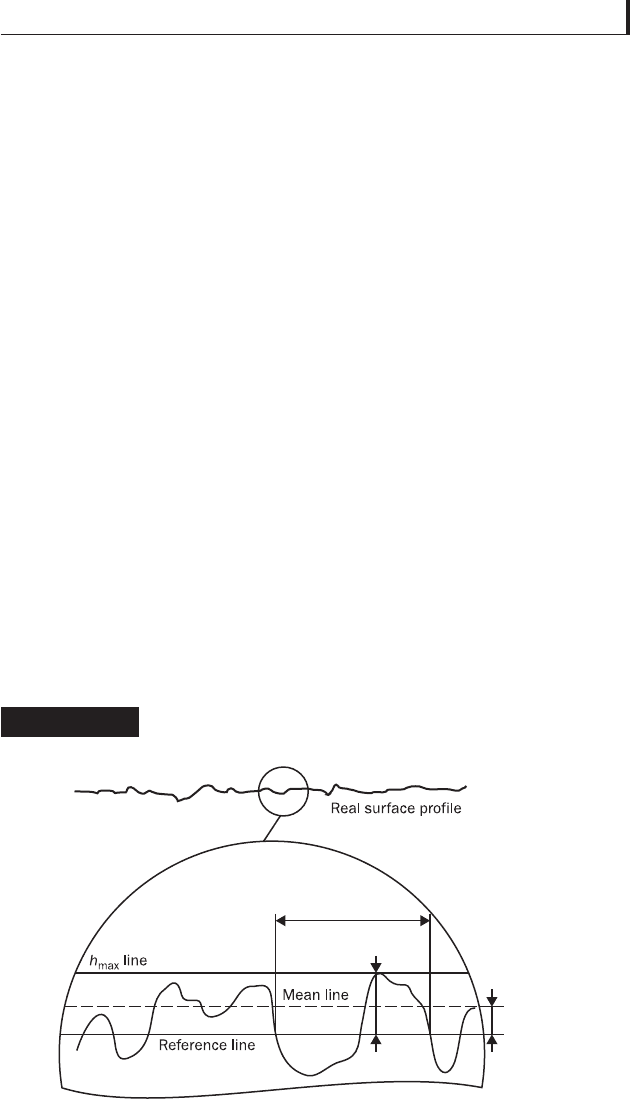
81
Lubrication and roughness
eccentricity; this fact should be borne in mind in the bearing
design when choosing the operating eccentricity.
3.6 Hydrodynamic lubrication of
roughened surfaces
The equations derived in the preceding sections are valid for
ideally smooth surfaces, which is not the case in practice.
Under the microscope we can see micro-deviations from the
ideal form; a schematic view of the roughness traced by
measurement stylus, together with some roughness
parameters, is presented in Fig. 3.7. Here R
a
is the mean
asperity height and S
i
and h
i
are the local roughness step and
height. There are also other roughness parameters specifi ed
in various national and international standards (e.g. ANSI,
DIN, ISO). So, the R
a
-values specifi ed by ISO are related
to the roughness grade number N (N1, N2, . . ., up to N11)
and range from 0.025 up to 25 μm accordingly. The mean
roughness step (interval between asperities), named
Real surface profi le and some roughness
parameters
Figure 3.7
S
i
h
i
R
a

82
Tribology for Engineers
sometimes roughness wavelength, varies in the wide range
3.5–75
μ
m; both roughness parameters are connected with
the type of surface fi nish, from lower values for fi ne machining
to higher values for rough machining.
The size of the surface asperities often equals and even
exceeds the fi lm thickness (see Section 3.2), thus they
naturally infl uence the hydrodynamic behaviour of the fi lm.
Knowing how the roughness parameters, asperity height R
a
and step S infl uence the fi lm pressure, the data obtained for
smooth surfaces can be adjusted with a view to more reliable
design of the machine parts.
Hydrodynamic lubrication of roughened surfaces has long
been an object of study at fl uctuating levels of intensity, see for
example Dowson et al. (1978). With the advent of laser
machining, interest in it has peaked again. A fl ow model was
developed by Patir and Cheng (1978, 1979) using averaged
roughness indices, and later gradually replaced by deterministic
models based on detailed roughness geometry. This approach
had already been attempted in early studies of microasperities
and microcavities (Anno and Walowit, 1968, 1969), and more
recently in that of regularly and irregularly covered porous
surfaces (Lai, 1994; Burstein and Ingman, 1999, 2000; Arghir
et al., 2003). Common to these studies is emphasis on the
integrated surface behaviour, it being assumed that the maximal
load support found for one microgroove is the same for all the
others; the cumulative effect is not considered. In general, it is
necessary to examine the entire profi le or, in three-dimensional
terms, the entire real surfaces separated by the lube.
Most recently in the last few decades, we are witnessing
a new approach whereby the opposite surfaces are
deterministically described by some idealized but unifi ed
expression, thus permitting in principle a theoretical solution
(Labiau et al., 2008; Letallear et al., 2002; Olver and Dini,
2007). One common model for regular structure surfaces is
the standardized version (e.g. ANSI/ASME Standard, 1985;

83
Lubrication and roughness
SRM 2073a, 1995) where the roughness is presented as a
sinusoidal ripple surface with a given frequency (Tønder,
1999, 2004) obtainable experimentally, e.g. the main
frequency of the spectral density function determined from
the spectral diagram of the concrete surface.
In parallel, 1D and 2D transient lubrication was
theoretically studied for surfaces with equal asperity sizes,
and fi nally generalized in a model representing unequal
roughnesses and unequal wavelengths along the axes – of
which the equal-roughness version is a particular case (see
Burstein, 2006, 2008, 2009). In these studies the opposite
surfaces also had equal wave numbers along the identical
axes. Under the generalized approach, sinusoidal roughness
and the same number of waves were assumed on both
surfaces. Lately non-sinusoidal 1D and 2D roughness models
were developed (Burstein, 2010), in which it was possible to
study the unequal case for both the asperity heights and
wavelengths. Hereafter two roughness types are briefl y
presented: sinusoidal and triangular wave confi gurations.
3.6.1 Roughness parameters and surface
roughness models
As was noted earlier, even perfectly fi nished machine parts
have haphazardly distributed numerous micro or nano peaks
and hollows refl ected in a similar pattern in the gap width
and correspondingly in the fi lm thickness geometry, with the
attendant diffi culties in theoretical and computerized
treatment. The main problem is that the randomly generated
opposite surfaces (see Fig. 3.8, surface generated by Matlab)
are in relative motion with the gap changing from moment
to moment, so that Reynolds’ equation cannot be solved
analytically. Numerical 1D or 2D solutions are also highly
problematic because of the large numbers of asperities on the
real surfaces.
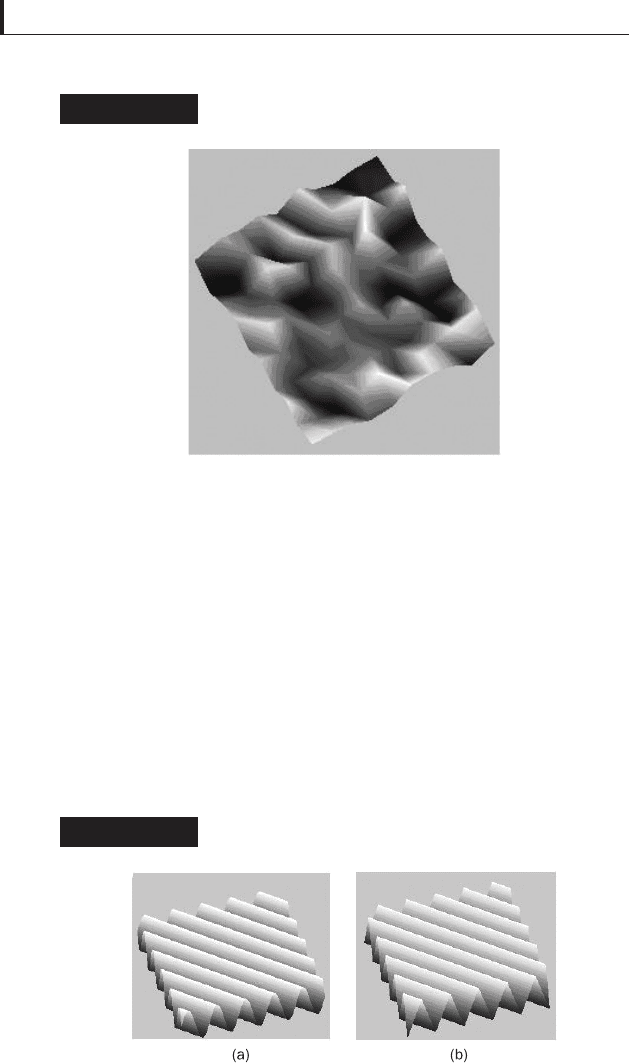
84
Tribology for Engineers
The problem becomes manageable if the profi le is
approximated by some regular confi guration, mostly by a
sinusoid or by a triangular wave function. A computer-
generated view of such surfaces, modelled in Matlab, is
presented in Fig. 3.9(a) and (b). In spite of the outward
similarity of these surfaces, the triangular pattern is maybe
more realistic than the sinusoidal – see Fig. 3.7. In any event,
applying these models permits better evaluation of the
surface indices, selecting those suitable for each specifi c case.
Computer image of surface with randomly
generated asperity heights and roughness step
Figure 3.8
Note: Asperity heights 2
μ
m, roughness step 2.5R
a
, standard deviation 0.2 of the
asperity height; fi ve asperities in each dimension; azimuth –31, elevation 86
Surface with sinusoidal (a) and triangular
(b) roughness
Figure 3.9
Note: Asperity heights 2
μ
m and roughness step 2.5R
a
, fi ve waves in each
dimension; azimuth –17, elevation 66

85
Lubrication and roughness
3.6.2 Hydrodynamic lubrication for
sinusoidal roughness
Reynolds’ equation can be rewritten in dimensionless form
as follows:
[3.26]
where
, and subscripts 1
and 2 denote the stationary and moving surfaces respectively.
The x-plane of the profi le geometry and the 3D view of the
surfaces are presented in Fig. 3.10.
With the surfaces in sinusoidal form, the dimensionless
gap is given by
[3.27]
where A
1
and A
2
are the dimensionless asperity heights,
A
1
= R
a
1
/(Δ + R
a
1
+ R
a
2
), A
2
= R
a
2
/(Δ + R
a
1
+ R
a
2
), and
1
= k
x
1
/k
z
1
and
2
= k
x
2
/k
z
2
are the wave ratios; k
x
1
, k
x
2
, k
z
1
, k
z
2
are the
wave numbers along the X and Z axes for surfaces 1 and 2;
Φ =
ϕ
/(2
π
L
x
) – the phase angle of the moving surface. Here
the roughnesses – R
a
1
, R
a
2
and the wave numbers k
x
1
, k
z
1
, k
x
2
,
k
z
2
– differ between the surfaces; and the origin of coordinates
is set such that the phase angle Φ
1
= 0.
Assuming that the surfaces have the same width and length
L
x
= L
z
= L or
S
= 1, and the same wave ratios
1
=
2
= ,
we can concentrate on two cases – (a) the wave numbers in
the X- and Z-directions being equal (scale factor = 1) and
(b) the wave numbers unequal (
1
≠
2
, scale factor ≠ 1).
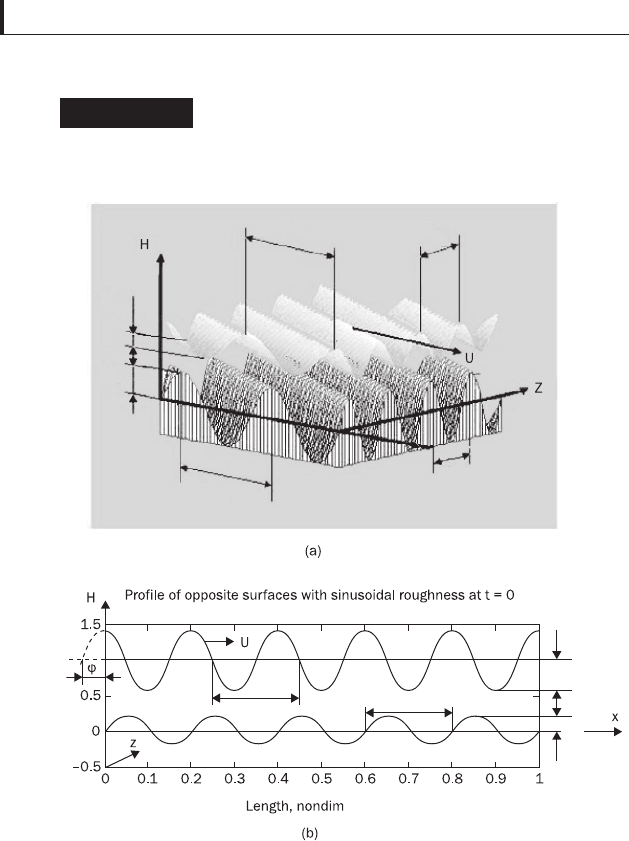
86
Tribology for Engineers
Solution for equal wave numbers
In the case of identical wavelength characteristics in both
the X- and Z-directions for the two surfaces,
1
=
2
= ,
and bearing in mind the trigonometric expressions for a
general sinusoid (see, for example, Bronshtein et al., 2007)
with amplitudes A
1
and A
2
, period 2
π
k, and phases Φ
1
= 0
R
a
2
X
R
a
1
R
a
2
R
a
1
lx
1
lx
2
lx
2
lx
1
lz
2
lx
1
δ
δ
Schematic of unequally roughened surfaces
(a) and gap geometry in X,H plane (b) at wave
number k = 5, roughness height ratio R
a
1
/
R
a
2
=
0.5, and phase displacement Φ = 1/(4k)
Figure 3.10
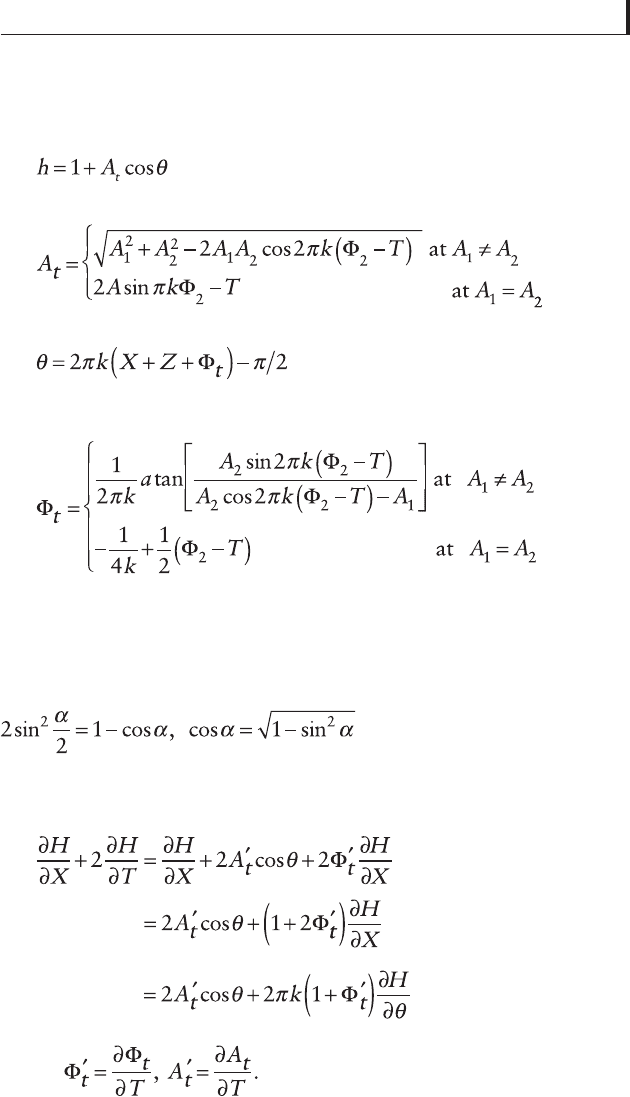
87
Lubrication and roughness
and (Φ
2
– T) for the moving surface, the gap as per eq. [3.27]
can be rewritten as
,
[3.28]
where
[3.29]
[3.30]
and
[3.31]
Here A
t
and Φ
t
represent the correlated roughness
and correlated phase angle respectively. For the case of
equal roughnesses A
1
= A
2
= A, the trigonometric relations
were used.
The derivatives on the right-hand side of eq. [3.26] can be
rewritten in terms of
θ
(eq. [3.30]) as:
where
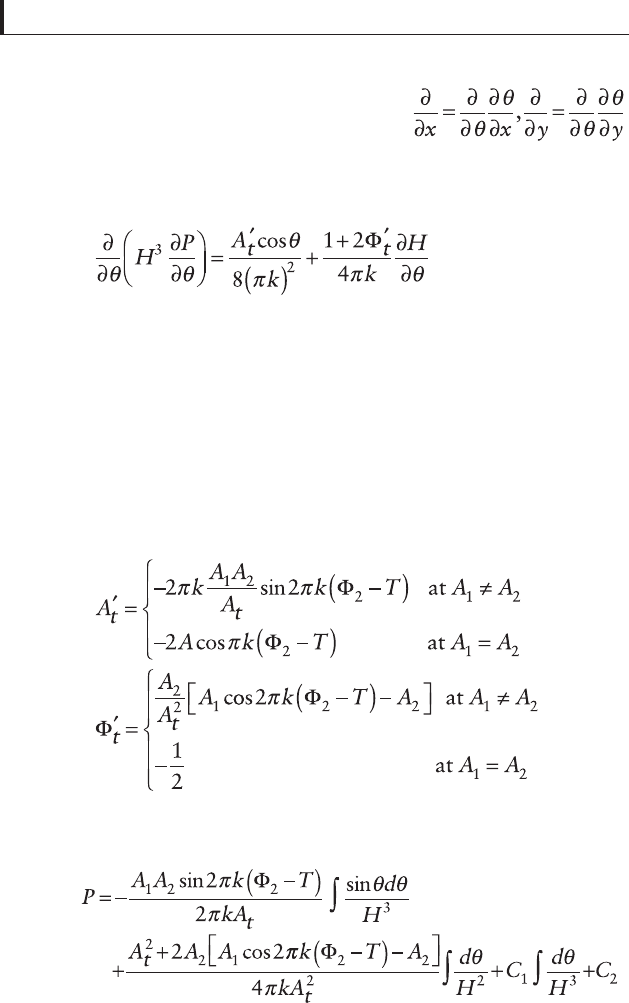
88
Tribology for Engineers
Bearing in mind the chain rule ,
eq. [3.26] can evidently be reduced to quasi-one-dimensional
form, namely to the ordinary differential equation
[3.32]
This operation is known in mathematical physics as the
‘travelling-wave’ solution (see, e.g., Polyanin et al., 2006), and
represents transition from the two- and three-dimensional
relations of types
ω
(x,y),
ω
(x,t),
ω
(x,y,t) to the one-dimensional
relation W(θ), in the case of the linear
θ
(x,y,t) form.
Expression [3.32] contains the derivatives of the correlated
roughness A
t
and phase angle Φ
t
; differentiating eqs. [3.29]
and [3.31], we have
[3.33]
Now, double integration of eq. [3.32] with respect to θ yields
[3.34]
where C
1
is an integration constant invariant in
θ
, and C
2
represents the pressure at the initial
θ
, also invariant in
θ
.
